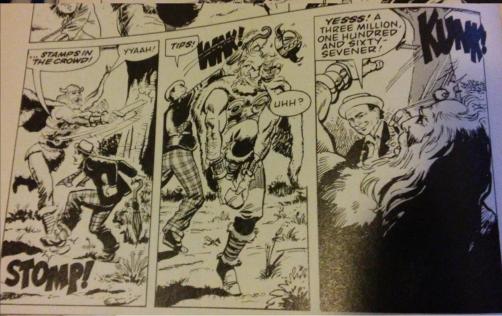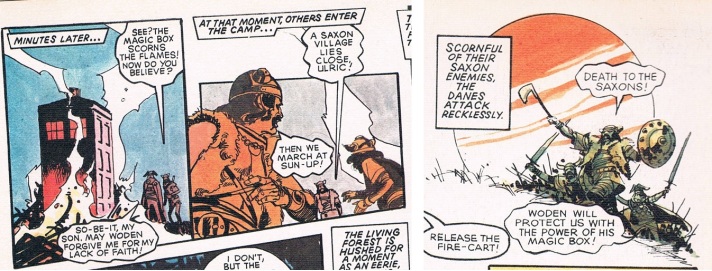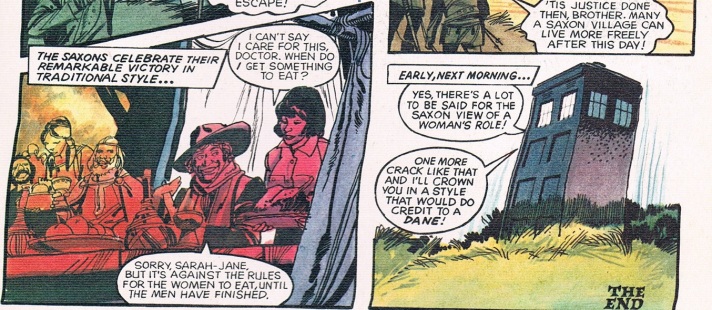The TARDIS occasionally found its way to early medieval England and these visits of the nation’s most beloved ‘Time Lord’ can also teach us something about Anglo-Saxon history and the Old English language. This post is the first of a series of three blogs that deal with the visits of BBC’s Doctor Who to Anglo-Saxon England.
Doctor Who in Anglo-Saxon England
Doctor Who is a science-fiction television programme, running from 1963 to 1989 and from 2005 to the present day. The programme revolves around the adventures of a mysterious ‘Time Lord’ who is known only as ‘The Doctor’, travelling through time and space in his TARDIS (which looks like a police box). In addition to his time travelling skills, the Doctor is also able to regenerate his body when near death, which explains why twelve different actors have been able to play this role in the TV series so far. Aside from time and space travel, the series is best known for its range of aliens and its horrible special effects. Incredibly popular, Doctor Who has become a significant part of British culture and has produced various spin-offs, in the form of magzines, novels, comic books and action figures.
Originally, Doctor Who was meant as a children’s TV show that would teach British history in a fun and entertaining way by bringing in aliens. What I am planning to do in the next few blogs is to use the series as it was intended: as a flashy guide to history; in my case, Anglo-Saxon history and culture. In order to do so, I have tried to locate TV episodes, comics and short fiction stories that feature the Doctor travelling to Anglo-Saxon England (my overview is unlikely to be complete, given the ever-growing Doctor Who franchise; recommendations are welcome, so please leave comments). We will see that the Doctor was present at many pivotal moments in Anglo-Saxon history; met various historical individuals; and, on occasion, prevented history from being changed forever. The current post deals with the Doctor’s encounters with Vikings and Anglo-Saxon celebrities; the second post will deal with King Alfred the Great and the third and last post will focus on the Doctor’s involvement in the Norman Conquest.
Doctor Conkerer: The Doctor in fifth-century Britain
The story of Anglo-Saxon England usually begins in the fifth century, when the Angles, Saxons and Jutes migrated to Britain. Naturally, some of these fifth-century invaders had a run-in with a blue police box, as is revealed in the comic strip ‘Doctor Conkerer’ in Dr. Who Magazine, no. 162 (July 1990):

In this comic, the seventh Doctor is playing a game of conkers (for which you need the seed of a horse-chestnut tree on a string – a conker). After he has run out of conkers, the Doctor decides to make a short stop to gather some more. The TARDIS lands in fifth-century Britain and the Doctor chances upon some ruffians shouting “YAARR!” and “RAAHH!”. Rather than meeting the Angles, Saxons or Jutes, as we might expect, he meets another group of Germanic invaders: the Vikings, some three hundred years before they actually set foot in Britain! Be that as it may, the Doctor witnesses these anachronistic Vikings capture a British boy and decides to come to the rescue. He burns the longships of the Vikings and knocks out Viking leader Olaf with a well-aimed strike of a conker:

The Doctor frees the British boy and brings him back to his village. Upon leaving the scene, the Doctor says to himself “Brilliant game, conkers. Wonder who first came up with it!”. This turns out to be the boy rescued by the Doctor, who is seen explaining the game to his mates. This first visit of the Doctor to early medieval Britain is slightly disappointing in terms of its educational value, if only because of the anachronisms (aside from the anachronistic Vikings, the game of conkers dates back to the 19th century).The next visit of the Doctor to early medieval Britain brings us into the territory of legend:
Shock reveal: The Doctor is Merlin!
According to the early medieval chroniclers Gildas (c. 500-570) and Bede (672/673-735), the Angles, Saxons and Jutes had been invited to Britain by the British King Vortigern, who required mercenaries to fight the invading Picts. A reference to this Vortigern is found in the TV episode ‘Battlefield’ (S26E01; 1989) of Doctor Who, in which a spaceship (containing the body of King Arthur and his sword Excalibur) is found on the bottom of Lake Vortigern…

Like Vortigern, the legendary King Arthur is also associated with the invading Anglo-Saxons. Later medieval writers, such as Geoffrey of Monmouth, have assumed that it was King Arthur who led the Britons in the fight against the invaders from the Continent. This British resistance is one of the reasons why it took the Anglo-Saxons at least 150 years to conquer the area that is now known as England.
As legend would have it, King Arthur was aided by a mysterious man who could predict the future: Merlin. ‘Battlefield’ reveals that this Merlin is none other than a reincarnation of the Doctor, as becomes clear when the knight Ancelyn flies through the roof of a hotel and recognises the seventh Doctor:
ANCELYN: Merlin. Against all hope.
….
ACE: You’ve got it wrong, mate. This is the Doctor.
ANCELYN: Oh, he has many faces, but in my reckoning, he is Merlin.
DOCTOR: You recognise my face, then?
ANCELYN: No, not your aspect, but your manner that betrays you. Do you not ride the ship of time? Does it not deceive the senses being larger within than out? Merlin, cease these games
There you have it, the British resistance against the Anglo-Saxons may have had some extraterrestrial help!
Woden’s Warriors: The Doctor meets some real Vikings
After the Anglo-Saxons have migrated and conquered most of what is now known as England, they are converted to Christianity. These events, however, seem to have gone by unaffected by the Doctor. His next visit (aside from a picnic with Bede, see below), takes place when the Anglo-Saxons themselves are faced with an invasion: the Vikings (for real, this time).
In ‘Woden’s warriors’, published in TV Comic Annual 1976, the fourth Doctor and his companion Sarah Jane accidentally land in Viking Age Britain. As they wander about, they suddenly hear the sounds of a horn: the Vikings have found the TARDIS and they think it is a gift from Woden. In order to find out whether that is truly the case, the Viking leader Heekon sets fire to the police box and, noting that it does not burn, he is convinced that this ‘magic box’ will aid them in their battle against the (Anglo-)Saxons:

The tide is not turned in the Vikings’ favour, however. The Saxons are prepared, since they have been forewarned by the Doctor and Sarah-Jane. The Vikings are put to flight and their boats are set aflame! Next, the Saxons celebrate their victory in ‘traditional style’, which means that Sarah-Jane is not allowed to eat before the men have finished. The Doctor chuckles: “Yes, there is a lot to be said for the Saxon view of a woman’s role”:

I, for one, am not aware of any such rule having been in place in Anglo-Saxon England; likely, this little scene is an attempt to show that rules that undermine a woman’s rights are ‘medieval’ and old-fashioned – Sarah-Jane’s repulsion seems in line with the second-wave feminism of the Seventies…
Who’s who in Anglo-Saxon England: The Doctor and Anglo-Saxon celebrities
Throughout the Doctor Who franchise, there are frequent references to historical figures that the Doctor had supposedly met. Some of these figures belong to Anglo-Saxon history. A prime example is the Venerable Bede (672/673-735), who once shared a salmon with the Doctor, as the fourth Doctor relates in the TV episode “The Talons of Weng-Chiang” (S14E06; 1977):
I caught a salmon there [the River Fleet] once. Would have hung over the sides of this table. Shared it with the venerable Bede, he adored fish.
One wonders what Bede, a Northumbrian monk who probably never went far beyond the confines of the monasteries in Monkwearmouth and Jarrow (now: Bede’s World), was doing in London at the time! Anyway, Bede’s predilection for fish may explain why the monk felt it necessary to point out that Britain “is remarkable also for rivers abounding in fish, and plentiful springs. It has the greatest plenty of salmon and eels” (Bede, Historia Ecclesiastica, bk. 1, ch. 1).

Another Anglo-Saxon celebrity known to the Doctor was King Athelstan (c.894–939), whose coronation in 924 is referred to in the 2009 TV-special “The Planet of the Dead”. Here, the tenth Doctor finds out that Lady Christina de Souza has stolen the precious ‘Cup of Athelstan’. This cup, we are told, was a gift from Hywel (c.880-950), King of the Welsh, to Athelstan upon the latter’s coronation in 924 as “the first king of Britain”. Even though Athelstan wasn’t really the first King of Britain, he was indeed crowned King of the Anglo-Saxons in 924. He became the first King of the English in 927, after he conquered the last remaining Viking kingdom of York. The Welsh kings did indeed submit to him, but he never really had the title of ‘first king of Britain’. Ah well, I suppose one can forgive a reincarnating, time and space travelling humanoid alien for not always having his facts straight!
If you like this post you may also like:

Great fun! I’m not sure where the idea of AS women having to eat after men comes from either but it’s an enduring myth. I can’t believe conkers only goes back to the 19th century… I will have to check that. Looking forward to tge next Dr Who installment.
LikeLike
Thanks for the comment 🙂 As for conkers, I get all my information from the BBC: http://www.bbc.co.uk/norfolk/kids/conkers_2.shtml Turns out, horse-chestnut trees weren’t even around in Britain before the 17th century…ah well 🙂
LikeLike
I can’t prove this, but Wikipedia (https://en.wikipedia.org/wiki/Bretwalda#Bretwaldas) says Athelstan was a “claimant” to the tile of “Bretwalda”, which can reasonably be translated “King of Britain”. Earlier holders of the title did not really rule all of Britain, as much of it was ruled by other Anglo-Saxon kings or by the Vikings. But as he seems to have been the first Bretwalda who ruled the whole of England as well as being the overlord of the kings in Scotland and Wales, it seems to me that the BBC’s formulation “first king of Britain” might be accurate enough in the context.
LikeLike
Hah..well you may have a point, but he wouldn’t have been ‘King of Britain’ by 924 at any rate (since he became King of the English in 927). 🙂
LikeLiked by 1 person